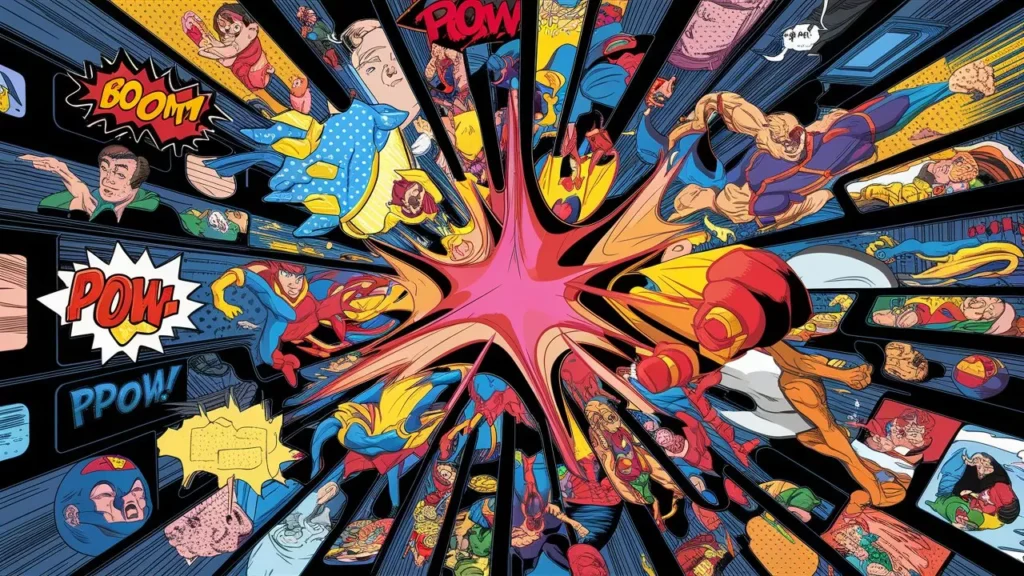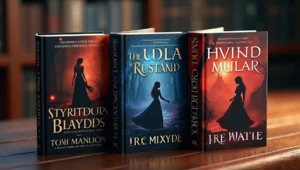Your Comic Dreams Are About to Come True!
Have you ever wanted to create your own comic strips but thought you needed to be a super artist to do it? Well, guess what? Those days are gone! Thanks to amazing AI tools, anyone can now make cool comics, even if they can’t draw a straight line with a ruler!
- Your Comic Dreams Are About to Come True!
- Why Use AI for Making Comics?
- 💖 You Might Also Like
- The Best AI Tools for Creating Comic Strips
- 1. Pixton
- 2. Comic AI (by Shortbread)
- ✨ More Stories for You
- 3. Canva’s AI Comic Maker
- 4. Neural Canvas
- 🌟 Don’t Miss These Posts
- 5. Midjourney (With Comic Prompts)
- 6. Storyboard That
- 7. Dashtoon Studio
- 8. DALL-E 3 (Through ChatGPT or Bing)
- 9. Comicgen
- 10. Make Beliefs Comix
- How to Choose the Right AI Comic Tool for You
- Tips for Making Amazing Comics with AI
- Start with a Clear Story
- Keep It Simple (Especially at First)
- Make Your Characters Look Consistent
- Use Clear Dialogue
- Think About Panel Layout
- Add Emotion and Expression
- Don’t Forget Sound Effects
- Test Your Comic on Someone Else
- Practice Makes Perfect
- Ideas for Comic Strips
- For Teachers:
- For Kids:
- For Hobbyists:
- For Storytellers:
- Real Success Stories
- Common Mistakes to Avoid
- The Future of AI Comic Creation
- Resources for Learning More
- Conclusion: Your Comic Journey Starts Now!
Whether you’re a teacher wanting to make learning fun, a hobbyist with stories to tell, or just someone who loves comics, this guide will show you the best AI tools that can turn your ideas into awesome comic strips. Let’s dive into this exciting world together!
Why Use AI for Making Comics?
Before we explore the best tools, let’s talk about why AI is so awesome for making comics.
It’s Super Fast
Creating a comic by hand can take hours or even days. With AI, you can make a whole comic strip in minutes! Imagine thinking of a funny joke in the morning and having a finished comic by lunchtime. That’s the power of AI!
You Don’t Need to Be an Artist
Remember when you had to spend years learning how to draw? Not anymore! AI tools can create beautiful artwork based on what you describe. You just type what you want, and boom – the AI draws it for you. It’s like having a magical art assistant!
It’s Affordable (or Even Free!)
Many AI comic tools are free or very cheap. This means you don’t need to spend lots of money on art supplies or expensive software. Some tools even let you create several comics every day without paying anything!
You Can Try Different Styles
Want your comic to look like manga today and like American superhero comics tomorrow? With AI, you can switch styles easily. It’s like having hundreds of different artists working for you!
💖 You Might Also Like
Perfect for Learning and Teaching
Teachers love AI comic tools because they make lessons more fun. Kids pay more attention when they see colorful comics instead of boring text. And students can create their own comics to show what they’ve learned!
The Best AI Tools for Creating Comic Strips
Now, let’s look at the best AI tools you can use right now. I’ll explain each one in simple words so everyone can understand!
1. Pixton
What Makes It Special?
Pixton is like a giant toy box full of comic-making tools. It’s one of the easiest platforms to use, especially for beginners and teachers. You don’t type descriptions here – instead, you drag and drop characters, backgrounds, and props to build your comic panels.
Who Should Use It?
- Teachers who want to make educational comics
- Kids who are just starting to make comics
- Anyone who likes clicking and dragging instead of typing
Cool Features:
- Huge library of ready-made characters you can customize
- Lots of backgrounds like schools, space, forests, and cities
- Easy panel layouts that snap together like LEGO blocks
- Characters can show different emotions with just one click
- Works great on computers and tablets
The Price:
Pixton has a free version where you can try it out. For teachers, they have special classroom plans that let many students use it at once. Personal plans start at around $9 per month.
Why Kids and Teachers Love It:
Pixton is super colorful and friendly. Kids can make comics about their book reports, science projects, or just for fun. Teachers can create comics to explain difficult topics like fractions, history events, or grammar rules. One teacher told me her students learned more about the water cycle from making comics than from reading textbooks!
2. Comic AI (by Shortbread)
What Makes It Special?
This tool uses super smart AI that understands your story and automatically creates comic panels. You write your story, and the AI does almost everything else – it creates characters, draws scenes, and even arranges the panels in a good order!
Who Should Use It?
- Storytellers who have great ideas but struggle with drawing
- Hobbyists who want to experiment with different art styles
- Anyone who wants to make comics really fast
Cool Features:
✨ More Stories for You
- Type your story, and watch it turn into a comic
- The AI keeps characters looking the same throughout your comic
- Multiple art styles to choose from
- Can create short comics or long graphic novels
- Easy sharing options for social media
The Price:
Comic AI offers a free trial so you can test it. After that, plans start at about $10-15 per month. They often have student discounts too!
Why It’s Great for Storytellers:
If you’re someone with lots of stories in your head, this tool is perfect. You don’t need to worry about drawing skills. Just focus on telling a great story, and the AI handles the visuals. One user made an entire 20-page comic about his cat’s adventures in just two days!
3. Canva’s AI Comic Maker
What Makes It Special?
You might know Canva as a design tool, but they now have AI features perfect for making comics! Canva combines templates with AI image creation, giving you the best of both worlds.
Who Should Use It?
- People who already use Canva for other projects
- Beginners who want lots of help and templates
- Social media creators making comic content
Cool Features:
- Thousands of comic templates to start with
- AI text-to-image generator called “Magic Media”
- Easy text bubble and caption tools
- Simple drag-and-drop interface
- Can download comics in different formats
The Price:
Canva has a generous free version. The Pro version costs about $13 per month and gives you more AI credits and templates.
Why It’s User-Friendly:
Canva makes everything simple. You pick a template, add your characters using AI, write your dialogue, and you’re done! It’s perfect for making quick comic strips for Instagram, Facebook, or classroom posters. Many teachers use Canva to create educational comics that look super professional.
4. Neural Canvas
What Makes It Special?
Neural Canvas specializes in creating AI-generated comic books with consistent artistic style. It’s designed specifically for people who want to create longer stories, not just single strips.
Who Should Use It?
🌟 Don’t Miss These Posts
- Hobbyists working on graphic novel projects
- Writers who want to visualize their stories
- Anyone creating educational comic books
Cool Features:
- Creates up to 100 illustrations at once
- Keeps characters looking consistent throughout
- Professional comic book styling
- Multiple genre options (fantasy, sci-fi, mystery, etc.)
- Can export as PDFs or individual images
The Price:
Neural Canvas works on a pay-per-book model. You might pay $15-25 per comic book creation, depending on length and features.
Why Long-Form Creators Love It:
If you’re writing a whole comic book or graphic novel, Neural Canvas helps maintain consistency. Your main character will look the same on page 1 and page 50! This is something many AI tools struggle with, making Neural Canvas special.
5. Midjourney (With Comic Prompts)
What Makes It Special?
Midjourney is one of the most powerful AI art generators available. While it’s not specifically a comic tool, many creators use it to make stunning comic panels by writing specific prompts.
Who Should Use It?
- Advanced users who want maximum creative control
- Hobbyists willing to learn prompt writing
- Artists who want unique, high-quality images
Cool Features:
- Incredibly detailed and beautiful artwork
- Complete control over art style
- Active community sharing tips and tricks
- Can create any style from manga to watercolor comics
- Produces high-resolution images
The Price:
Midjourney starts at about $10 per month for the basic plan, with higher tiers for more generations.
Learning Curve Alert:
Midjourney is more difficult to use than other tools on this list. You need to learn how to write good prompts (descriptions) to get what you want. But once you learn, the results are amazing! Think of it like learning to ride a bike – tricky at first, but then you can go anywhere!
6. Storyboard That
What Makes It Special?
This tool focuses on educational comics and storyboards. It’s used by thousands of teachers worldwide and has features specifically designed for classroom use.
Who Should Use It?
- Teachers creating educational materials
- Students doing school projects
- Parents helping kids with homework
Cool Features:
- Huge library of educational characters and props
- Historical figures and period-specific backgrounds
- Scientific diagrams and symbols
- Lesson plan templates included
- Safe environment for kids
The Price:
Storyboard That has a limited free version. Education licenses start at about $9 per month for teachers, with discounts for schools buying multiple licenses.
Educational Superpowers:
Teachers can create comics about any subject – math word problems become comic adventures, historical events come alive, and grammar lessons get funny. Students can make comics to show they understand topics, which is way more fun than writing essays!
7. Dashtoon Studio
What Makes It Special?
Dashtoon is a newer platform that combines AI art generation with traditional comic creation tools. It’s designed specifically for making webtoons and vertical scrolling comics.
Who Should Use It?
- Webtoon creators and manga fans
- Mobile-first comic creators
- Anyone wanting to publish comics online
Cool Features:
- AI character consistency tools
- Webtoon-style vertical layouts
- Built-in community and publishing platform
- Style presets for manga, anime, and western comics
- Mobile app for creating on the go
The Price:
Dashtoon offers a free tier with limited features. Premium plans start around $12 per month.
Perfect for Modern Comics:
If you love reading webtoons on your phone, Dashtoon lets you create them! The vertical scrolling format is perfect for mobile readers, and you can share your comics directly on their platform.
8. DALL-E 3 (Through ChatGPT or Bing)
What Makes It Special?
DALL-E 3 is OpenAI’s powerful image generator. You can access it through ChatGPT Plus or Microsoft’s Bing Image Creator (which is free!). It creates realistic or artistic images from text descriptions.
Who Should Use It?
- Anyone on a tight budget (Bing version is free!)
- Creators who want photorealistic comic styles
- Hobbyists experimenting with different approaches
Cool Features:
- Understands complex descriptions really well
- Free access through Bing
- Creates 4 images per prompt
- Good at following specific instructions
- Can do various art styles
The Price:
Free through Bing Image Creator, or $20/month with ChatGPT Plus (which includes many other features).
Why It’s Accessible:
The free version through Bing makes this tool available to everyone! You can create dozens of comic panels without spending a penny. Many hobbyists start here before moving to more specialized comic tools.
9. Comicgen
What Makes It Special?
Comicgen is a simple, free tool created by Gramener. It doesn’t use AI generation but rather provides customizable character builder templates. Think of it as a digital paper doll system for comics.
Who Should Use It?
- Beginners who find AI tools confusing
- Teachers wanting quick, simple comics
- Anyone needing consistent characters
Cool Features:
- Completely free and open-source
- No sign-up required
- Works directly in your web browser
- Simple character customization
- Easy to use with kids
The Price:
Totally free! No hidden costs, no subscriptions.
Perfect for Starting Out:
If all these AI tools sound complicated, start with Comicgen. It’s super simple – pick a character, choose their pose and expression, add a speech bubble, and you’re done! Many teachers use this for quick classroom activities.
10. Make Beliefs Comix
What Makes It Special?
This is another free, simple tool perfect for kids and classrooms. It has a friendly interface and focuses on ease of use over fancy features.
Who Should Use It?
- Elementary school teachers
- Young kids making their first comics
- Anyone wanting zero complications
Cool Features:
- Free and educational-focused
- Thousands of characters and props
- Multiple languages available
- Kid-safe environment
- Printable comics
The Price:
100% free for educational use!
Great for Kids:
The simple drag-and-drop interface means even first-graders can make comics. Kids can choose characters, add speech bubbles, and tell their stories without any adult help. It’s also great for teaching language skills!
How to Choose the Right AI Comic Tool for You
With so many options, how do you pick the right one? Let’s make it simple!
For Teachers:
Choose Pixton, Storyboard That, or Make Beliefs Comix. These tools are made with classrooms in mind and are safe for kids.
For Hobbyists with Stories to Tell:
Try Comic AI, Neural Canvas, or Dashtoon Studio. These let you focus on storytelling while AI handles the art.
For Beginners:
Start with Canva, Make Beliefs Comix, or Comicgen. These are easy to learn and won’t overwhelm you.
For Advanced Creators:
Explore Midjourney or DALL-E 3. These give you more control but need practice to master.
For People on a Budget:
Use Bing’s DALL-E 3, Comicgen, or Make Beliefs Comix. All are free!
For Social Media Content:
Canva is perfect because it’s designed for creating shareable content quickly.
Tips for Making Amazing Comics with AI
Now that you know the tools, here are some secrets to making great comics!
Start with a Clear Story
Even the best AI can’t fix a confusing story. Before you start creating, answer these questions:
- What happens in my comic?
- Who are the main characters?
- What’s the funny part or important message?
- How does it end?
Write a quick outline, even if it’s just a few sentences. This will guide you as you create.
Keep It Simple (Especially at First)
Don’t try to make a 50-page graphic novel on your first try! Start with a simple 3-panel comic strip. Once you’re comfortable, you can make longer comics.
A classic comic structure is:
- Setup (introduce the situation)
- Development (something happens)
- Punchline (the funny or important ending)
Make Your Characters Look Consistent
One challenge with AI is keeping characters looking the same in every panel. Here are tricks to help:
- Write very detailed descriptions of your characters and use them every time
- Save the AI-generated images you like and try to match them
- Some tools have “character consistency” features – use them!
- Keep characters wearing the same clothes throughout your comic
Use Clear Dialogue
Speech bubbles should be easy to read. Keep your sentences short and simple. If a character talks too much in one panel, the bubble gets huge and covers the art!
Good dialogue in comics:
- Is short and snappy
- Sounds like how people really talk
- Moves the story forward
- Matches the character’s personality
Think About Panel Layout
How you arrange your panels matters! Most simple comic strips use:
- Three horizontal panels for quick jokes
- Four-panel square grid for stories
- Vertical panels for dramatic moments
- Mix of sizes for dynamic action
Most AI tools have templates to help you with this!
Add Emotion and Expression
Comics aren’t just about what happens – they’re about how characters feel! Make sure your characters show emotions through:
- Facial expressions (happy, sad, surprised, angry)
- Body language (standing tall, slouching, jumping)
- Speech bubbles (exclamation marks, question marks, different sizes)
AI tools usually let you specify emotions like “happy character” or “surprised expression.”
Don’t Forget Sound Effects
BAM! POW! WHOOSH! Sound effects make comics more exciting! Most comic tools let you add text for sound effects. Make them:
- Big and bold for loud sounds
- Wavy or shaky for weird sounds
- Different fonts from regular dialogue
Test Your Comic on Someone Else
Before you share your comic with the world, show it to a friend or family member. Ask them:
- Did you understand the story?
- Was it funny or interesting?
- Were any parts confusing?
Fresh eyes can spot problems you might miss!
Practice Makes Perfect
Your first comic might not be perfect, and that’s okay! Every comic you make will teach you something new. Famous comic creators made hundreds of comics before they got really good. So keep creating!
Ideas for Comic Strips
Stuck on what to make comics about? Here are lots of ideas!
For Teachers:
- Math word problems as comic adventures
- Historical events with dialogue
- Science concepts explained by cartoon characters
- Grammar rules shown in funny situations
- Book summaries in comic form
- Character analysis from stories you’re reading
- “A day in the life of…” historical figures
- Step-by-step instructions for science experiments
For Kids:
- Your pet’s secret life
- Superhero adventures
- Diary comics about your day
- “What if” scenarios (What if dinosaurs went to school?)
- Jokes and funny moments
- Adventures with your friends
- Fantasy worlds you imagine
- How you spent your weekend
For Hobbyists:
- Slice-of-life moments
- Social commentary through humor
- Fantasy or sci-fi stories
- Adaptations of books you love
- Autobiographical comics
- Fan comics of your favorite characters
- Daily comic strips (like a comic diary)
- Tutorials or how-to guides in comic form
For Storytellers:
- Short stories broken into comic panels
- Character origin stories
- Mysteries or detective tales
- Romance comics
- Horror or suspense stories
- Alternate history scenarios
- Mythology retellings
- Epic adventures
Real Success Stories
Let me share some inspiring stories of people using AI comic tools:
Mrs. Johnson’s 5th Grade Class
Mrs. Johnson was struggling to get her students interested in history. Then she discovered Pixton. She created a comic about the American Revolution where the founding fathers were superheroes. Her students loved it so much that they asked to make their own historical comics. Now, every student creates comics for their reports, and test scores have improved!
Tom’s Webtoon Dream
Tom always wanted to create a webtoon but couldn’t draw well. He discovered Dashtoon Studio and started making “Coffee Shop Chronicles,” a funny series about working in a café. After six months of posting weekly, his comic now has over 10,000 followers! He creates each episode in just a few hours using AI.
Sarah’s Teaching Resources
Sarah is a homeschool mom who uses Canva to make educational comics for her three kids. She creates custom math worksheets, reading comprehension comics, and even science experiment instructions—all in comic format. Her kids say learning is “way more fun now,” and other homeschool families buy her comic resource packs online!
The Miller Family Comic Project
The Miller family started making comics together every Sunday afternoon. Dad writes the stories, Mom helps with editing, and their two kids (ages 8 and 11) choose the characters and expressions using Make Beliefs Comix. They’ve created over 50 family comics and made them into a book for Grandma’s birthday. It’s become their favorite family tradition!
Common Mistakes to Avoid
Learn from others’ mistakes so you don’t make them yourself!
Too Much Text
Comics are visual storytelling! If your panels are 90% text, you’re making an illustrated story, not a comic. Show things through pictures when you can, and only use words when necessary.
Inconsistent Art Styles
Switching between realistic, cartoon, and manga styles in one comic can be jarring. Pick a style and stick with it throughout your story.
Confusing Panel Order
Western comics read left-to-right, top-to-bottom. Manga reads right-to-left. Make sure your readers know which way to read your comic! Number your panels if needed.
Ignoring Copyright
If you use AI to create comics of existing characters you don’t own (like Spider-Man or Pokemon), you can’t sell those comics. It’s fine for personal projects or classroom use, but not for commercial purposes.
Giving Up Too Soon
AI tools have learning curves. Your first few comics might not look exactly how you imagined. Keep practicing! Watch tutorials, join online communities, and learn from each comic you make.
Forgetting to Save Your Work
Always save your work frequently! Many AI tools use credits or generations, and you don’t want to lose a great panel because you forgot to save it.
The Future of AI Comic Creation
The world of AI comics is growing super fast! Here’s what’s coming:
Better Character Consistency
AI tools are getting better at remembering characters. Soon, you’ll be able to create a character once, and the AI will keep them looking identical in every panel automatically.
Voice and Animation
Some tools are starting to add voice to comics, creating “motion comics.” You might soon make comics that your readers can watch and listen to!
Collaborative AI
Imagine an AI that understands your story so well it can suggest plot twists, funny jokes, or dramatic moments! These “story assistant” AIs are being developed now.
More Languages
AI comic tools are adding support for more languages, making comic creation accessible worldwide. Soon, you’ll be able to create comics in any language you speak!
Virtual Reality Comics
Some companies are experimenting with VR comics where you can step inside the comic world and look around. How cool is that?
Resources for Learning More
Want to dive deeper into comic creation? Here are great places to learn:
Websites:
- Scott McCloud’s “Understanding Comics” (the book and website explain how comics work)
- Comic creation subreddits where creators share tips
- YouTube channels teaching comic creation
- Online courses on platforms like Skillshare and Udemy
Communities:
- Join Facebook groups for comic creators
- Discord servers for AI art enthusiasts
- Forums specific to your chosen AI tool
- Local comic creation meetups or clubs
Books:
- “Making Comics” by Scott McCloud
- “The DC Comics Guide to Writing Comics” by Dennis O’Neil
- “Words for Pictures” by Brian Michael Bendis
Conclusion: Your Comic Journey Starts Now!
You’ve just learned about the best AI tools for creating comics, from simple free options to powerful advanced platforms. The most important thing to remember is this: the best tool is the one you’ll actually use!
Don’t get stuck trying to find the “perfect” tool. Pick one that sounds good, start creating, and have fun! Comics are about sharing stories, making people laugh, teaching ideas, or just expressing yourself. Whether you’re a teacher helping students learn, a hobbyist with tales to tell, or just someone who thinks comics are cool—AI tools have made it easier than ever to bring your ideas to life.
Start small. Make a simple three-panel comic about something that happened to you today. Share it with a friend. Make another one tomorrow. Before you know it, you’ll have created dozens of comics, and each one will be better than the last.
The world needs more stories, more laughter, and more creativity. With AI comic tools, you have the power to add your voice to the wonderful world of comics. So what are you waiting for? Your first comic strip is just waiting to be created!
Remember: every professional comic creator started exactly where you are now – with an idea and the courage to try. The only difference between them and you is that they started. So go ahead, pick a tool from this guide, and start your comic-creating adventure today!
Happy comic making, future comic creators! Your story matters, and now you have the tools to share it with the world! 🎨✨📚















